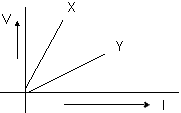|
Physics
Class-
XII 1997(CBSE)
You are on Set
no 1 Qno. 1 to 20
Time allowed : 3
hours
Maximum Marks : 70
General Instructions :
(i) All
questions are compulsory.
(ii) Marks for each question are
indicated against it.
(iii) Question number 1 to 8 are very
short-answer questions each of 1 mark. Answer them in about one
sentence each.
(iv) Question number 9 to 18 are short-answer
questions of 2 marks. Answer them in not more than 30 words
each.
(v) Question number 19 to 27 are short-answer questions of
3 marks. Answer them in not more than 50 words each.
(vi)
Question number 28 to 30 are long-answer questions of 5 marks each.
Answer to these questions should be around 150 words each.
(vii)
Use Log Tables, if necessary.
Q1) Horizontal component of Earth's magnetic field at a place
is  3 times the vertical component. What is the value of
angle of dip at this place? (Marks 1) 3 times the vertical component. What is the value of
angle of dip at this place? (Marks 1)
Q2) Force between two point electric charges kept at a
distance d apart in air is F. If these charges are kept at
the same distance in water, how does the force between them
change? (Marks 1)
Q3) Give any two factors on which thermo-electric emf
produced in a thermo-couple depends. (Marks 1)
Q4) The electric current in a wire in the direction from B to
A is decreasing. What is the direction of induced current in the
metallic loop kept above the wire as shown in the figure?
(Marks 1)

Q5) Name the electromagnetic radiations used for viewing
objects through haze and fog. (Marks 1)
Q6) Give the ratio of the number of holes and the number of
conduction electrons in an intrinsic semiconductor. (Marks
1)
Q7) In the given diagram, is the diode D forward or reversed
biased? (Marks 1)

Q8) Name the planet which has maximum value of albedo.
(Marks 1)
Q9) Two point electric charges of unknown magnitude and sign
are placed a distance 'd' apart. The electric field intensity
is zero at a point, not between the charges but on the line joining
them. Write two essential conditions for this to happen.
(Marks 2)
Q10) The variation of potential difference V with length l in
case of two potentiometers X and Y is as shown in the given diagram.
Which one of these two will you prefer for comparing emf's to two
cells and why? (Marks 2)

Q11) Name any one material having a small value of temperature
coefficient of resistance. Write one use of this material.
(Marks 2)
Q12) Write two advantages and two disadvantages of a secondary
cell over a primary cell. (Marks 2)
Q13) In the figure, the straight wire AB is fixed while the
loop is free to move under the influence of the electric currents
flowing in them. In which direction does the loop begin to move?
Give reason for your answer. (Marks 2)

Q14) A radio frequency choke is air-cored coil whereas in
audio frequency choke is iron-cored. Give reasons for this
difference. (Marks 2)
Q15) An astronomical telescope consists of two thin lenses set
36 cm apart and has a magnifying power 8. Calculate the focal
lengths of the lenses. (Marks 2)
Q16) Use the mirror formula to show that for an object lying
between the pole and focus of a concave mirror, the image formed is
always virtual in nature. (Marks 2)
Q17) An  -particle and a proton are accelerated through the same
potential difference. Calculate the ratio of velocities acquired by
the two particles. (Marks 2) -particle and a proton are accelerated through the same
potential difference. Calculate the ratio of velocities acquired by
the two particles. (Marks 2)
Q18) Describe the method used for determination of distance of
a planet by parallax method. (Marks 2)
Q19) Explain the principle of a tangent galvanometer. How does
the reduction factor of the galvanometer change, when (i) number of
turns of the coil is increased and (ii) radius of the coil is
decreased? Give reason for your answer in each case. (Marks
3)
Q20) A wire of uniform cross-section and length l has a
resistance of 16  . It is cut into four equal
parts. Each part is stretched uniformly to length l and all the four
stretched parts are connected in parallel. Calculate the total
resistance of the combination so formed. Assume that stretching of
wire does not cause any change in the density of its material.
(Marks 3) . It is cut into four equal
parts. Each part is stretched uniformly to length l and all the four
stretched parts are connected in parallel. Calculate the total
resistance of the combination so formed. Assume that stretching of
wire does not cause any change in the density of its material.
(Marks 3)
|
